Synergistic Effects of DHA and Sucrose on Body Weight Gain in PUFA-Deficient Elovl2 -/- Mice
Abstract
1. Introduction
2. Material and Methods
2.1. Animal Handling and Experimental Set Up
2.2. MRI Measurements
2.3. Quantitative RT-PCR
2.4. Glucose Tolerance Tests
2.5. Blood TG and Cholesterol Levels
2.6. Serum/Plasma Leptin and Insulin Levels
2.7. Serum Lipoprotein Profile (FPLC)
2.8. Intestinal Lipid Uptake Test
2.9. Statistical Analysis
3. Results
3.1. DHA Supplementation Together with High Sucrose Content Induces Body Weight Gain of Elovl2 -/- Mice
3.2. Effects of High Sucrose and DHA Supplementation on Energy Intake
3.3. DHA Supplementation and High-Sucrose Content Improves Food Utilization Efficiency
3.4. Effects of High Sucrose and DHA Supplementation on Glucose Metabolism
3.5. Effects of DHA and Sucrose on Lipid Metabolism Markers
4. Discussion
Supplementary Materials
Author Contributions
Funding
Acknowledgments
Conflicts of Interest
Abbreviations
References
- Todorčević, M.; Hodson, L. The effect of marine derived n-3 fatty acids on adipose tissue metabolism and function. J. Clin. Med. 2015, 5. [Google Scholar] [CrossRef] [PubMed]
- Jump, D.B. Fatty acid regulation of hepatic lipid metabolism. Curr. Opin. Clin. Nutr. Metab. Care 2011, 14, 115–120. [Google Scholar] [CrossRef]
- Flachs, P.; Rossmeisl, M.J. The effect of n-3 fatty acids on glucosehomeostasis and insulin sensitivity. Physiol. Res. 2014, 63 (Suppl. S1), S93–S118. [Google Scholar] [PubMed]
- Lalia, A.Z.; Lanza, I.R. Insulin-sensitizing effects of omega-3 fatty acids: Lost in translation? Nutrients 2016, 8. [Google Scholar] [CrossRef] [PubMed]
- Borkman, M.; Storlien, L.H.; Pan, D.A.; Jenkins, A.B.; Chisholm, D.J.; Campbell, L.V. The relation between insulin sensitivity and the fatty-acid composition of skeletal-musclephospholipids. N. Engl. J. Med. 1993, 328, 238–244. [Google Scholar] [CrossRef]
- Agrawal, R.; Gomez-Pinilla, F. ‘Metabolic syndrome’ in the brain: Deficiency in omega- 3 fatty acid exacerbates dysfunctions in insulin receptor signalling and cognition. J. Physiol. 2012, 590, 2485–2499. [Google Scholar] [CrossRef] [PubMed]
- Moon, Y.A.; Hammer, R.E.; Horton, J.D. Deletion of ELOVL5 leads to fatty liver through activation of SREBP-1c in mice. J. Lipid Res. 2009, 50, 412–423. [Google Scholar] [CrossRef]
- Tripathy, S.; Torres-Gonzalez, M.; Jump, D.B. Elevated hepatic fatty acid elongase-5 activity corrects dietary fat-induced hyperglycemia in obese C57BL/6J mice. J. Lipid Res. 2010, 51, 2642–2654. [Google Scholar] [CrossRef]
- Stoffel, W.; Hammels, I.; Jenke, B.; Binczek, E.; Schmidt-Soltau, I.; Brodesser, S.; Odenthal, M.M. Obesity resistance and deregulation of lipogenesis in Delta6-fatty acid desaturase (FADS2) deficiency. EMBO Rep. 2014, 15, 110–120. [Google Scholar] [CrossRef]
- Tvrdik, P.; Westerberg, R.; Silve, S.; Asadi, A.; Jakobsson, A.; Cannon, B.; Loison, G.A. Role of a new mammalian gene family in the biosynthesis of very long chain fatty acids and sphingolipids. J. Cell Biol. 2000, 149, 707–718. [Google Scholar] [CrossRef]
- Guillou, H.; Zadravec, D.; Martin, P.G.; Jacobsson, A. The key roles of elongases and desaturases in mammalian fatty acid metabolism: Insights from transgenic mice. Prog. Lipid Res. 2010, 49, 186–199. [Google Scholar] [CrossRef]
- Pauter, A.M.; Olsson, P.; Asadi, A.; Herslof, B.; Csikasz, R.I.; Zadravec, D.; Jacobsson, A. Elovl2 ablation demonstrates that systemic DHA is endogenously produced and is essential for lipid homeostasis in mice. J. Lipid Res. 2014, 55, 718–728. [Google Scholar] [CrossRef]
- Madsen, L.; Kristiansen, K. Of mice and men: Factors abrogating the anti obesity effect of omega-3 fatty acids. Adipocyte 2012, 1, 173–176. [Google Scholar] [CrossRef] [PubMed][Green Version]
- Johnson, R.J.; Sanchez-Lozada, L.G.; Andrews, P.; Lanaspa, M.A. Perspective: A historical and scientific perspective of sugar and its relation with obesity and diabetes. Adv. Nutr. 2017, 8, 412–422. [Google Scholar] [CrossRef]
- Go, R.E.; Hwang, K.A.; Park, G.T.; Lee, H.M.; Lee, G.A.; Kim, C.W.; Jeon, S.Y.; Seo, J.W.; Hong, W.K.; Choi, K.C. Effects of microalgal polyunsaturated fatty acid oil on body weight and lipid accumulation in the liver of C57BL/6 mice fed a high fat diet. J. Biomed. Res. 2016, 30, 234–242. [Google Scholar] [PubMed]
- Schoemaker, M.H.; Kleemann, R.; Morrison, M.C.; Verheij, J.; Salic, K.; van Tol, E.A.; Kooistra, T.; Wielinga, P.Y. A casein hydrolysate based formulation attenuates obesity and associated non-alcoholic fatty liver disease and atherosclerosis in LDLr-/-.leiden mice. PLoS ONE 2017, 12, e0180648. [Google Scholar] [CrossRef] [PubMed]
- Jump, D.B.; Depner, C.M.; Tripathy, S.; Lytle, K.A. Potential for dietary omega-3 fatty acids to prevent nonalcoholic fatty liver disease and reduce the risk of primary liver cancer. Adv. Nutr. 2015, 6, 694–702. [Google Scholar] [CrossRef] [PubMed]
- Lauritzen, L.; Brambilla, P.; Mazzocchi, A.; Harsløf, L.; Ciappolino, V.; Agostoni, C. DHA effects in brain development and function. Nutrients 2016, 8. [Google Scholar] [CrossRef] [PubMed]
- Mathai, M.L.; Soueid, M.; Chen, N.; Jayasooriya, A.P.; Sinclair, A.J.; Wlodek, M.E.; Weisinger, H.S.; Weisinger, R.S. Does perinatal omega-3 polyunsaturated fatty acid deficiency increase appetite signaling? Obes. Res. 2004, 12, 1886–1894. [Google Scholar] [CrossRef]
- Goncalves, C.G.; Ramos, E.J.; Romanova, I.V.; Suzuki, S.; Chen, C.; Meguid, M.M. Omega-3 fatty acids improve appetite in cancer anorexia, but tumor resecting restores it. Surgery 2006, 139, 202–208. [Google Scholar] [CrossRef] [PubMed]
- Ramos, E.J.; Romanova, I.V.; Suzuki, S.; Chen, C.; Ugrumov, M.V.; Sato, T.; Goncalves, C.G.; Meguid, M.M. Effects of omega-3 fatty acids on orexigenic and anorexigenic modulators at the onset of anorexia. Brain Res. 2005, 1046, 157–164. [Google Scholar] [CrossRef] [PubMed]
- Fan, Y.Y.; Monk, J.M.; Hou, T.Y.; Callway, E.; Vincent, L.; Weeks, B.; Yang, P.; Chapkin, R.S. Characterization of an arachidonic acid-deficient (Fads1 knockout) mouse model. J. Lipid Res. 2012, 53, 1287–1295. [Google Scholar] [CrossRef] [PubMed]
- Ma, T.; Liaset, B.; Hao, Q.; Petersen, R.K.; Fjære, E.; Ngo, H.T.; Lillefosse, H.H.; Ringholm, S.; Sonne, S.B.; Treebak, J.T.; et al. Sucrose counteracts the anti-inflammatory effect of fish oil in adipose tissue and increases obesity development in mice. PLoS ONE 2011, 6, e21647. [Google Scholar] [CrossRef]
- Ma, T.; Liaset, B.; Hao, Q.; Petersen, R.K.; Fjære, E.; Ngo, H.T.; Lillefosse, H.H.; Ringholm, S.; Sonne, S.B.; Treebak, J.T.; et al. High-glycemic index carbohydrates abrogate the antiobesity effect of fish oil in mice. Am. J. Physiol. Endocrinol. Metab. 2012, 302, E1097–E1112. [Google Scholar]
- Todoric, J.; Löffler, M.; Huber, J.; Bilban, M.; Reimers, M.; Kadl, A.; Zeyda, M.; Waldhäusl, W.; Stulnig, T.M. Adipose tissue inflammation induced by high-fat diet in obese diabetic mice is prevented by n-3 polyunsaturated fatty acids. Diabetologia 2006, 49, 2109–2119. [Google Scholar] [CrossRef]
- Ohminami, H.; Amo, K.; Taketani, Y.; Sato, K.; Fukaya, M.; Uebanso, T.; Arai, H.; Koganei, M.; Sasaki, H.; Yamanaka-Okumura, H.; et al. Dietary combination of sucrose and linoleic acid causes skeletal muscle metabolic abnormalities in zucker fatty rats through specific modification of fatty acid composition. J. Clin. Biochem. Nutr. 2014, 55, 15–25. [Google Scholar] [CrossRef] [PubMed]
- Simopoulos, A.P. Dietary omega-3 fatty acid deficiency and high fructose intake in the development of metabolic syndrome, brain metabolic abnormalities, and non-alcoholic fatty liver disease. Nutrients 2013, 5, 2901–2923. [Google Scholar] [CrossRef]
- Cruciani-Guglielmacci, C.; Bellini, L.; Denom, J.; Oshima, M.; Fernandez, N.; Normandie-Levi, P.; Berney, X.P.; Kassis, N.; Rouch, C.; Dairou, J.; et al. Molecular phenotyping of multiple mouse strains under metabolic challenge uncovers a role for Elovl2 in glucose-induced insulin secretion. Mol. Metab. 2017, 6, 340–351. [Google Scholar] [CrossRef]
- Bellini, L.; Campana, M.; Rouch, C.; Chacinska, M.; Bugliani, M.; Meneyrol, K.; Hainault, I.; Lenoir, V.; Denom, J.; Véret, J.; et al. Protective role of the ELOVL2/docosahexaenoic acid axis in glucolipotoxicity-induced apoptosis n rodent beta cells and human islets. Diabetologia 2018, 61, 1780–1793. [Google Scholar] [CrossRef]
- Pifferi, F.; Roux, F.; Langelier, B.; Alessandri, J.M.; Vancassel, S.; Jouin, M.; Lavialle, M.; Guesnet, P. (N-3) polyunsaturated fatty acid deficiency reduces the expression of both isoforms of the brain glucose transporter GLUT1 in rats. J. Nutr. 2005, 135, 2241–2246. [Google Scholar] [CrossRef]
- Ximenes da Silva, A.; Lavialle, F.; Gendrot, G.; Guesnet, P.; Alessandri, J.M.; Lavialle, M. Glucose transport and utilization are altered in the brain of rats deficient in n-3 polyunsaturated fatty acids. J. Neurochem. 2002, 81, 1328–1337. [Google Scholar] [CrossRef]
- Zadravec, D.; Brolinson, A.; Fisher, R.M.; Carneheim, C.; Csikasz, R.I.; Bertrand-Michel, J.; Borén, J.; Guillou, H.; Rudling, M.; Jacobsson, A. Ablation of the very-long-chain fatty acid elongase ELOVL3 in mice leads to constrained lipid storage and resistance to diet-induced obesity. FASEB J. 2010, 24, 4366–4377. [Google Scholar] [CrossRef] [PubMed]
- Stern, J.H.; Rutkowski, J.M.; Scherer, P.E. Adiponectin, leptin, and fatty acids in the maintenance of metabolic homeostasis through adipose tissue crosstalk. Cell Metab. 2016, 23, 770–784. [Google Scholar] [CrossRef]
- Kobayashi, T.; Zadravec, D.; Jacobsson, A. ELOVL2 overexpression enhances triacylglycerol synthesis in 3T3-L1 and F442A cells. FEBS Lett. 2007, 581, 3157–3163. [Google Scholar] [CrossRef] [PubMed]
- Talamonti, E.; Pauter, A.M.; Asadi, A.; Fischer, A.W.; Chiurchiù, V.; Jacobsson, A. Impairment of systemic DHA synthesis affects macrophage plasticity and polarization: Implications for DHA supplementation during inflammation. Cell Mol. Life Sci. 2017, 74, 2815–2826. [Google Scholar] [CrossRef] [PubMed]
- Bargut, T.C.L.; Santos, L.P.; Machado, D.G.L.; Aguila, M.B.; Mandarim-de-Lacerda, C.A. Eicosapentaenoic acid (EPA) vs. docosahexaenoic acid (DHA): Effects in epididymal white adipose tissue of mice fed a high-fructose diet. Prostaglandins Leukot. Essent. Fatty Acids 2017, 123, 14–24. [Google Scholar] [CrossRef]
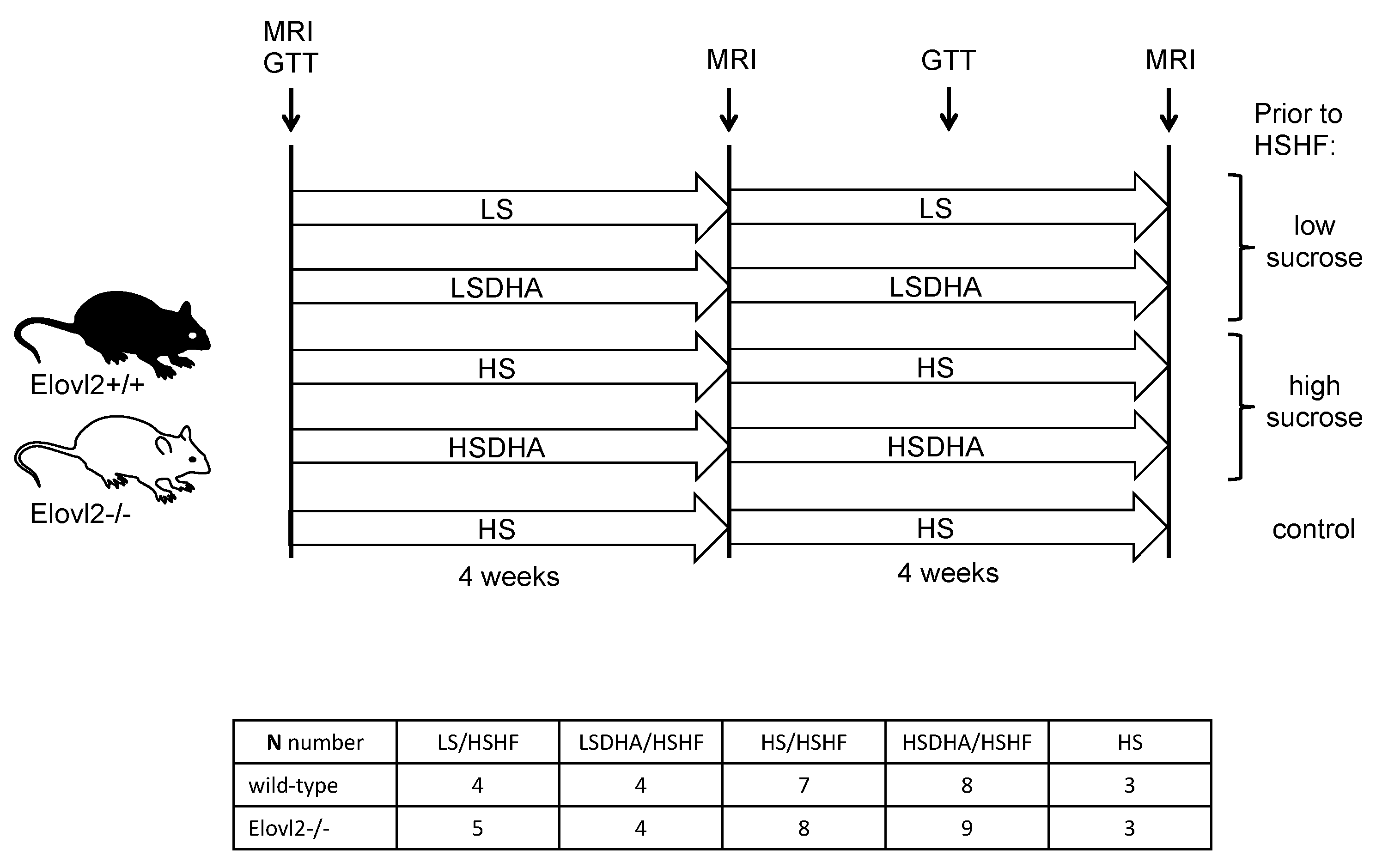
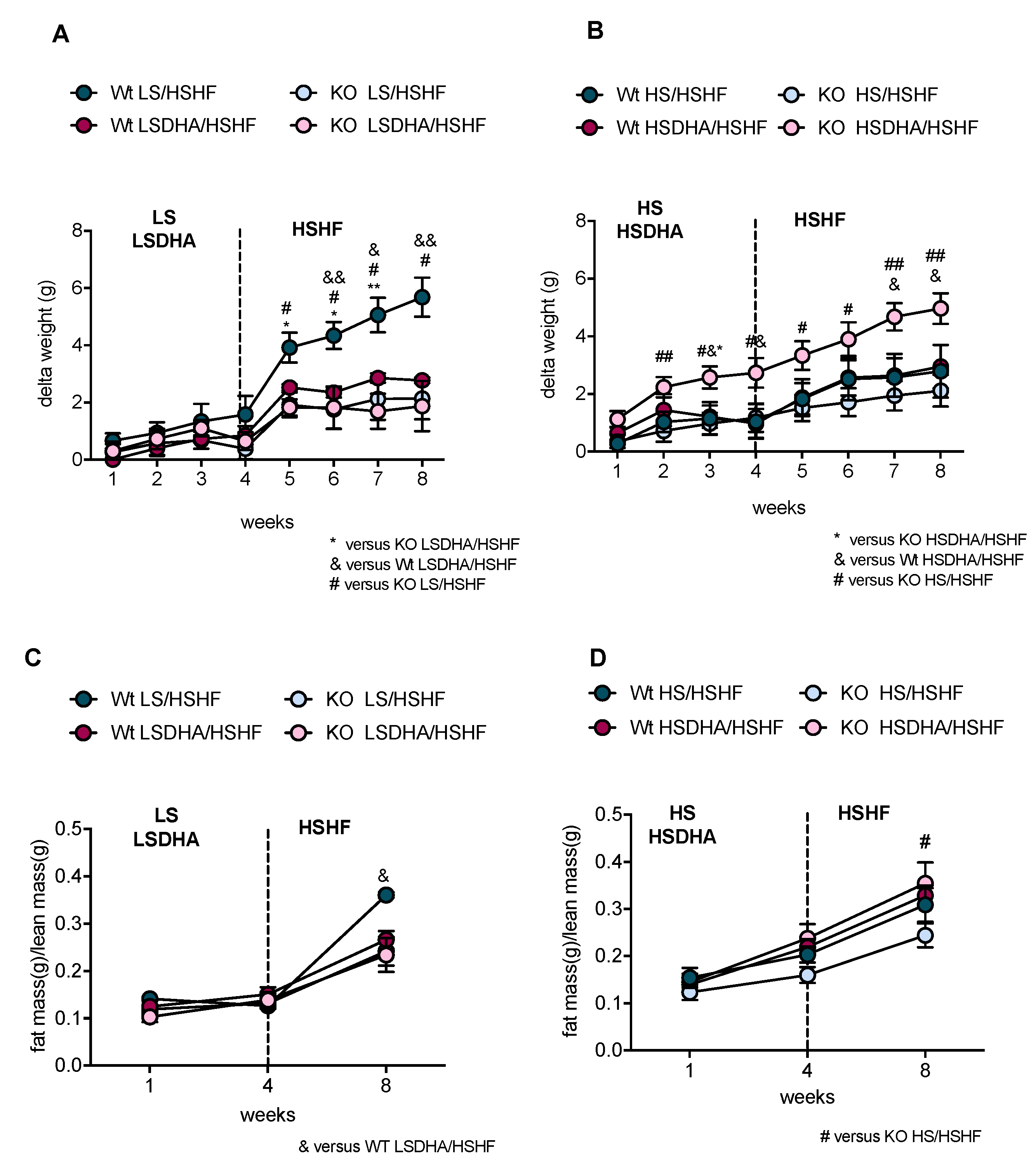
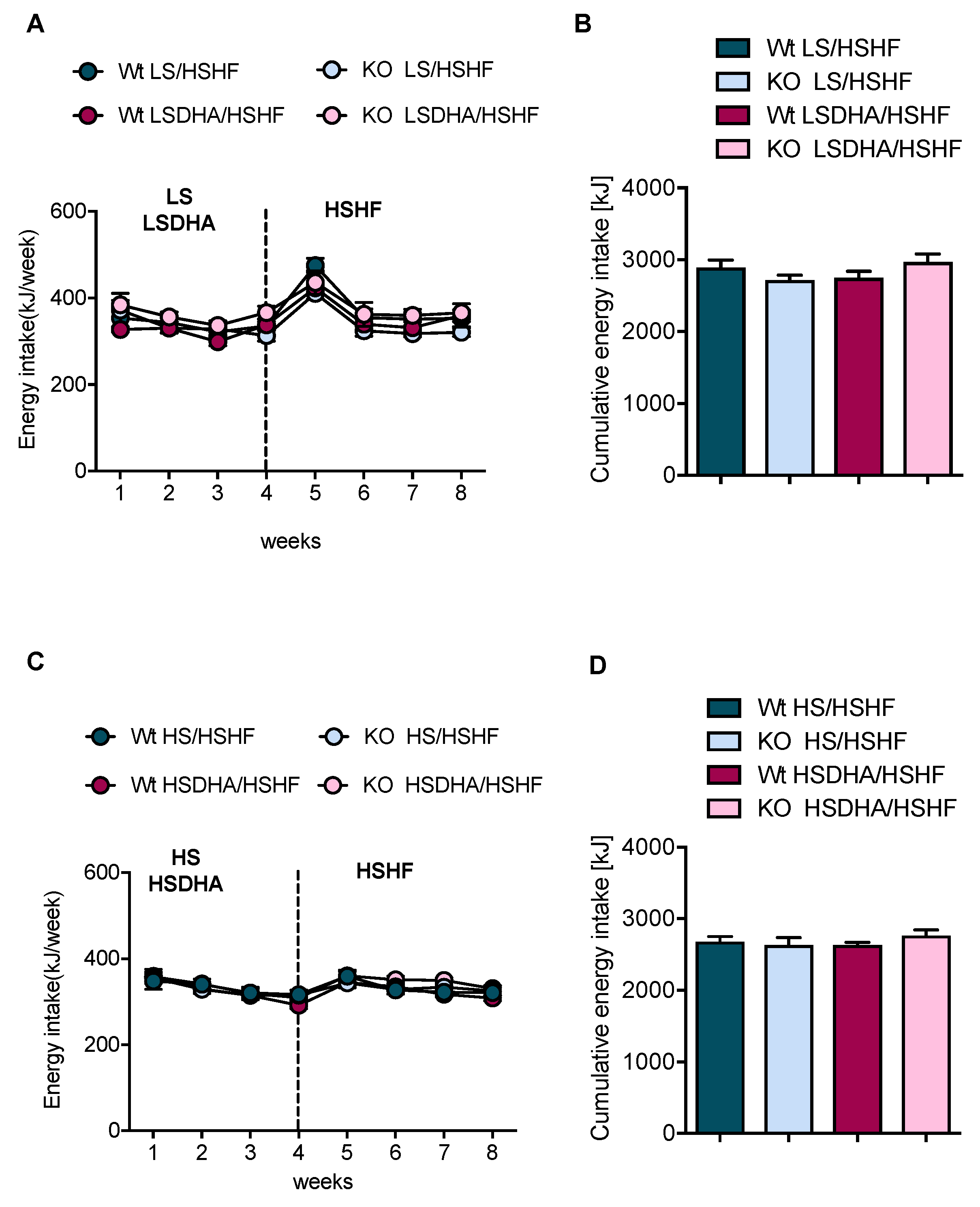

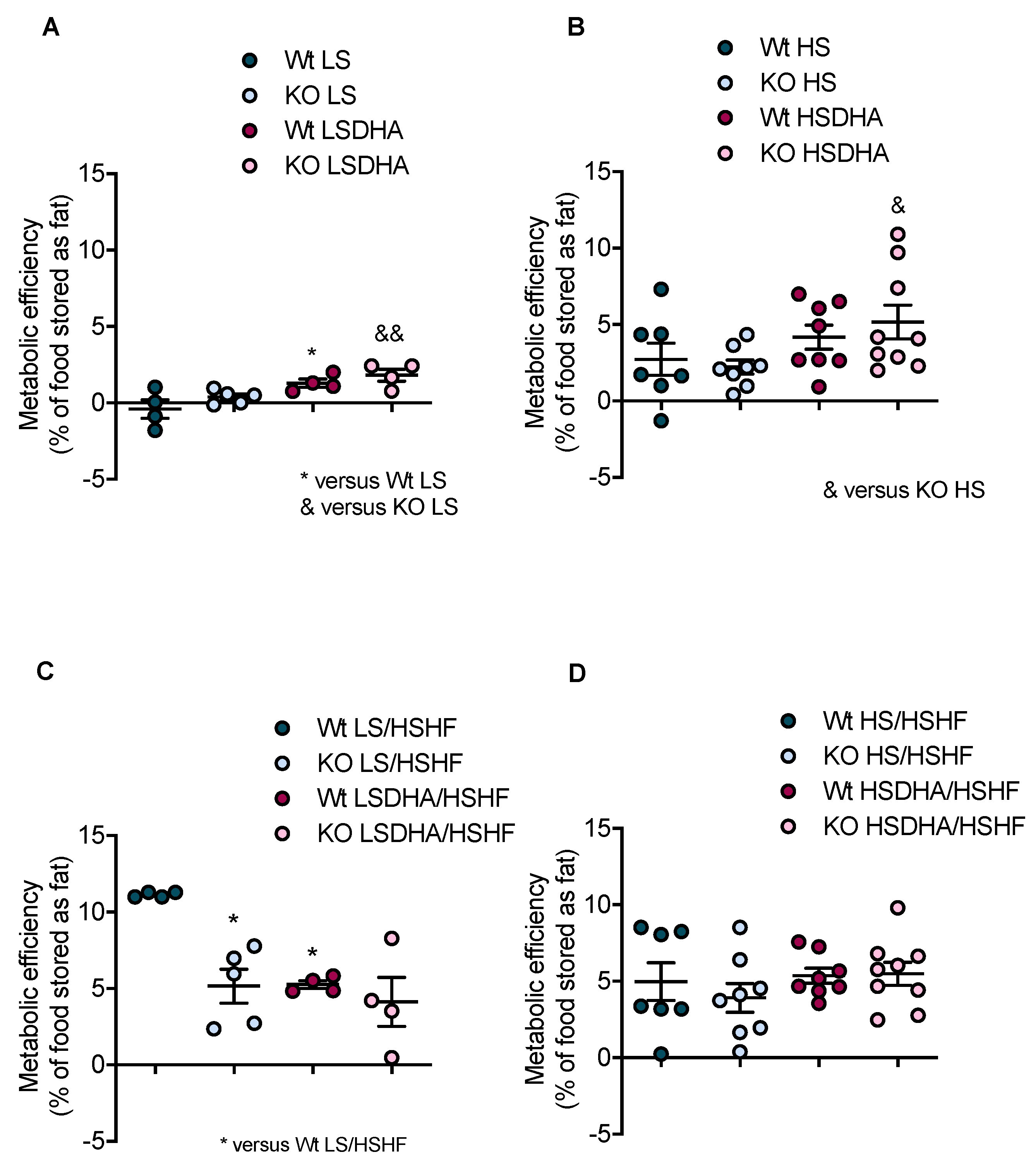
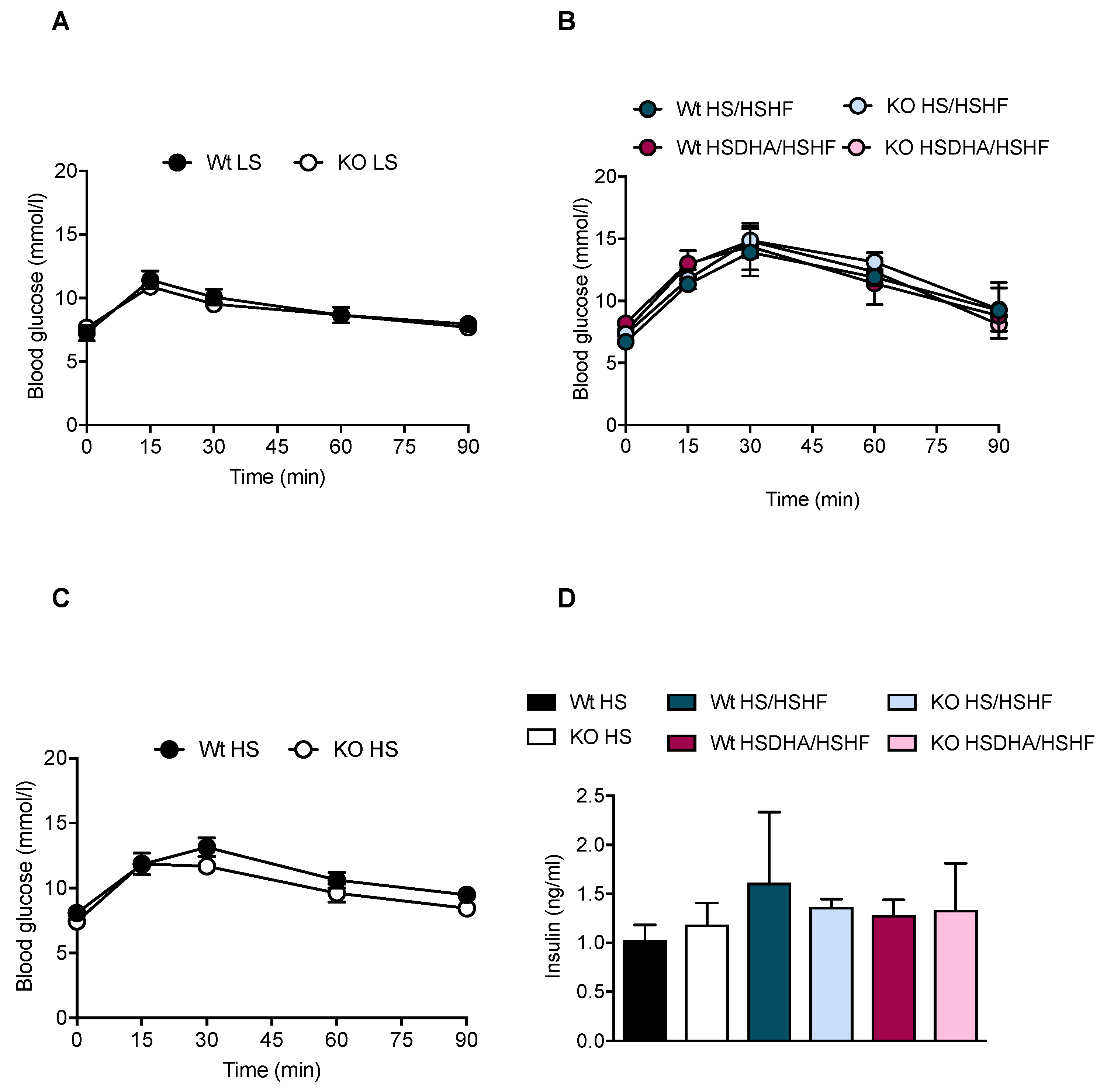

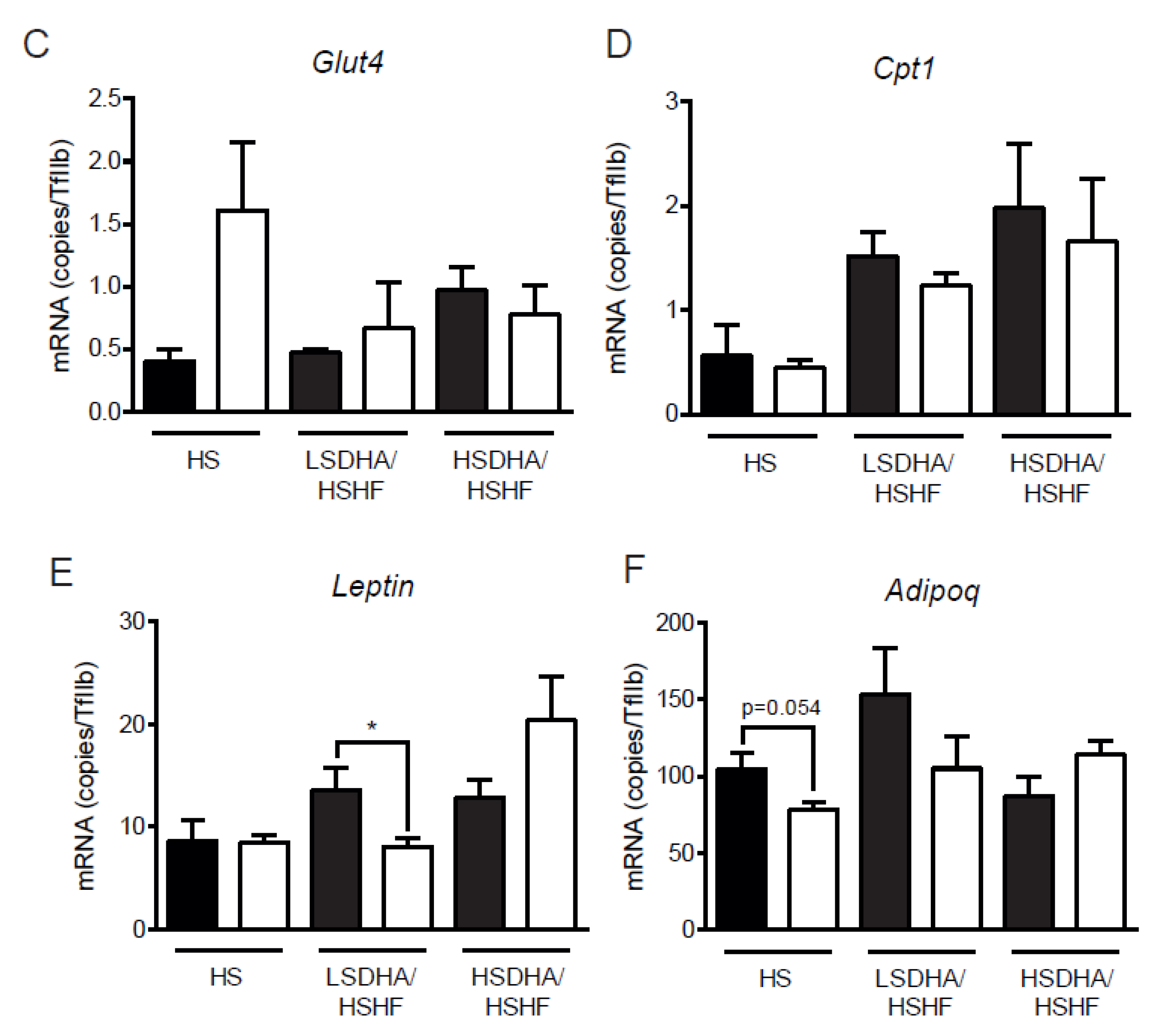

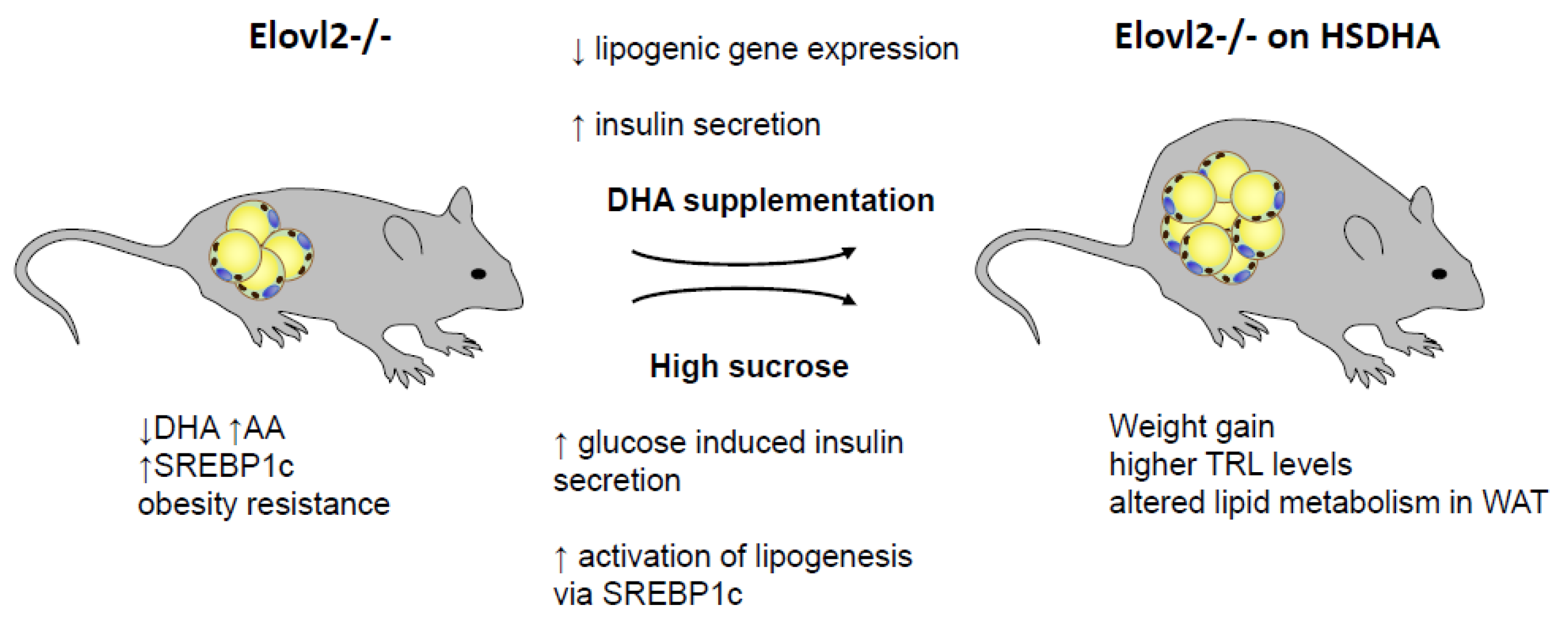
| Ingredients | No Sucrose Diet (LS) (10% kcal fat) D12450B | No Sucrose DHA-Enriched Diet (LSDHA) (10% kcal fat, 1% DHA) D14062901 | High Sucrose Diet (HS) (10% kcal fat) D12450H | High Sucrose DHA-Enriched Diet (hsdha) (10% kcal fat, 1% DHA) D13021002 | High Sucrose, High Fat Diet (HSHF) (45% kcal fat) D12451 |
|---|---|---|---|---|---|
| Casein | 200 | 200 | 200 | 200 | 200 |
| L-Cystine | 3 | 3 | 3 | 3 | 3 |
| Corn starch | 315 | 550 | 452.2 | 452.2 | 72.8 |
| Maltodextrin 10 | 35 | 150 | 75 | 75 | 100 |
| Sucrose | 0 | 0 | 172.8 | 172.8 | 172.8 |
| Cellulose, BW200 | 50 | 50 | 50 | 50 | 50 |
| Soybean oil | 25 | 25 | 25 | 25 | 25 |
| DHA | 0 | 10 | 0 | 10 | 0 |
| Lard | 20 | 10 | 20 | 10 | 177.5 |
| Mineral Mix S10026 | 10 | 10 | 10 | 10 | 10 |
| DiCalcium Phosphate | 13 | 13 | 13 | 13 | 13 |
| Calcium Carbonate | 5.5 | 5.5 | 5.5 | 5.5 | 5.5 |
| Potassium Citrate, 1H20 | 16.5 | 16.5 | 16.5 | 16.5 | 16.5 |
| Vitamin Mix V10001 | 10 | 10 | 10 | 10 | 10 |
| Choline Bitartrate | 2 | 2 | 2 | 2 | 2 |
| FD&C Yellow Dye #5 | 0 | 0 | 0.04 | 0 | 0 |
| FD&C Red Dye #40 | 0 | 0.05 | 0.01 | 0.025 | 0.05 |
| FD&C Blue Dye #1 | 0 | 0 | 0 | 0.025 | 0 |
| Total (g) | 705 | 1055.5 | 1055.5 | 1055.05 | 858.15 |
| Initial Parameters | Wt HS (8 weeks) | KO HS (8 weeks) |
| Body weight (g ± SEM) | 29.9 ± 1.2 | 27.8 ± 1.6 |
| Lean weight (g± SEM) | 22.05 ±0.99 | 20.74 ± 1.34 |
| Fat mass (g± SEM) | 3.22 ± 0.14 | 2.75 ± 0.09 |
| Final Parameters | Wt HS (8 weeks) | KO HS (8 weeks) |
| Body weight (g± SEM) | 30.4 ± 0.7 | 27.2 ± 0.2 |
| Lean weight (g± SEM) | 20.29 ± 0.39 | 19.07 ± 0.74 |
| Fat mass (g± SEM) | 4.98 ± 0.37 | 3.52 ± 0.29 |
| Weekly Food Consumption (kJ/week ± SEM) | 325.1± 6.4 | 313.7 ± 14.9 |
| Cumulative energy intake (kJ/8 weeks± SEM) | 2600.9 ± 51.0 | 2509.5 ± 119.5 |
| Metabolic efficiency (% of food store as fat) | 2.5 | 1.1 |
© 2019 by the authors. Licensee MDPI, Basel, Switzerland. This article is an open access article distributed under the terms and conditions of the Creative Commons Attribution (CC BY) license (http://creativecommons.org/licenses/by/4.0/).
Share and Cite
Pauter, A.M.; Fischer, A.W.; Bengtsson, T.; Asadi, A.; Talamonti, E.; Jacobsson, A. Synergistic Effects of DHA and Sucrose on Body Weight Gain in PUFA-Deficient Elovl2 -/- Mice. Nutrients 2019, 11, 852. https://doi.org/10.3390/nu11040852
Pauter AM, Fischer AW, Bengtsson T, Asadi A, Talamonti E, Jacobsson A. Synergistic Effects of DHA and Sucrose on Body Weight Gain in PUFA-Deficient Elovl2 -/- Mice. Nutrients. 2019; 11(4):852. https://doi.org/10.3390/nu11040852
Chicago/Turabian StylePauter, Anna M., Alexander W. Fischer, Tore Bengtsson, Abolfazl Asadi, Emanuela Talamonti, and Anders Jacobsson. 2019. "Synergistic Effects of DHA and Sucrose on Body Weight Gain in PUFA-Deficient Elovl2 -/- Mice" Nutrients 11, no. 4: 852. https://doi.org/10.3390/nu11040852
APA StylePauter, A. M., Fischer, A. W., Bengtsson, T., Asadi, A., Talamonti, E., & Jacobsson, A. (2019). Synergistic Effects of DHA and Sucrose on Body Weight Gain in PUFA-Deficient Elovl2 -/- Mice. Nutrients, 11(4), 852. https://doi.org/10.3390/nu11040852





